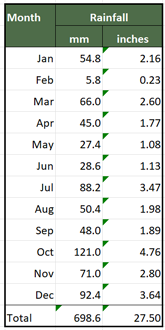Sunday’s weather was an improvement over Saturday as the showers stayed away although it was very breezy and the clouds often threatened showers but they never actually materialised.
My garlic spray experiment got under way. Garlic bulbs were crushed and simmered lightly for 5 minutes.
After simmering for the required time the resulting garlicky brew was left for a few hours to go cold before being decanted into an old milk container. I took a few photos of our hostas planted in large pots around the pond before spraying. It would be lovely to keep these plants’ leaves hole free through the summer. A real test for the garlic spray.
Some hostas are looking really good just now and completely free of slug or snail damage. It’s an extra challenge to keep them this way around the pond as fish are normally extremely sensitive to any garden chemicals and hence we make sure no chemicals go anywhere near these hostas.
A couple of hostas already have a bit of slug or snail damage. This isn't too bad and if spraying with garlic keeps the blighters under control and avoids complete devastation which has happened in the past I’ll be pleased.
Once the spray was cold I mixed up a sprayful of the liquid. The recipe suggested that one tablespoon should be mixed with one gallon of water. As I had another 4 pint milk container handy I decided to use 1 tablespoon of my concentrated garlic solution to one carton or 4 pints of water.
I gave all our potted hostas, greenhouse plants and cold frame plants a spray along with a couple of free range hostas growing in a garden border. I have to admit there didn't seem to be much of a garlic aroma from the spray and I decided to add another tablespoon of concentrate to my mixed up liquid.
I gave all the plants another spray in the early evening on the grounds the leaves may still be wet with the solution when the slugs and snails came out to feed.
So the hope is that we can prevent the hostas from looking like this. We do have much worse damage than shown in this picture but it’s obviously something we don't make a point of photographing.
Watch this space to see how our garlic spray experiment performs.




























That's whetted the appetite. I'm watching!
ReplyDeleteWatching Beechgrove last week Jim McColl mentioned that they used a garlic spray once a fortnight in the fruit cage. He described it as a growth enhancer rather than a pesticide. We'll see how it goes. (Factsheet 6 I think)
DeleteI think by simmering for 5 minutes you might have lost some of the volatile essential oils. The method I use is to whizz the bulbs up in half a pint of hot water until smooth, and add a further one and a half pints of hot water, put it in a sealed vessel for 3 days, strain the liquid and dilute 10 to 1 with plain water.
ReplyDeleteRegards,
Ken
I watch the youtube video on your last comment. From the Internet both methods of producing the spray seem to have their devotees. I went for the simmering method as it produced a ready to use spray the same day. I'll probably give the blender method a go too now I've got some solution to use.
DeleteMartyn
I should add, 10 being water, 1 being garlic.
ReplyDeleteWaiting to see if it works....
ReplyDeleteI'll be very pleased if it does Ana.
Delete